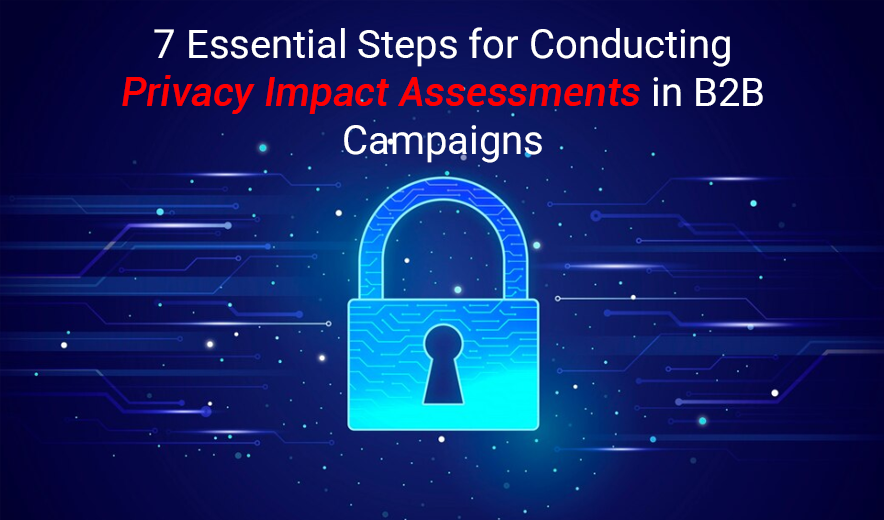Privacy Impact Assessments (PIAs) are essential for B2B campaigns. With stringent data privacy regulations like GDPR and CCPA, businesses must ensure compliance while working towards their goals.
Impact of Privacy Impact Assessments on B2B Marketing
As businesses navigate the complexities of data privacy regulations, PIAs have become essential for sustainable growth and compliance. They offer various advantages to businesses like:
Enhanced Trust and Credibility
Privacy Impact Assessments (PIAs) significantly enhance trust and credibility with clients. B2B clients are often more concerned about data privacy due to the sensitive nature of the information involved. Demonstrating a commitment to data protection through regular PIAs reassures clients that their data gets handled responsibly.
Example: Salesforce conducts thorough PIAs and demonstrates compliance can attract more clients who prioritize data security.
Improved Risk Management
Privacy Impact Assessments (PIAs) help identify and mitigate privacy risks before they become issues. Businesses can uncover potential vulnerabilities and address them proactively by systematically assessing data processing activities. It prevents data breaches and minimizes financial and reputational damage.
According to the ‘Cost of a Data Breach Report 2023’ by IBM, the average data breach cost is 25% lower for organizations that conduct regular PIAs.
Compliance with Regulations
Regulatory bodies like GDPR and CCPA mandate PIAs for high-risk data processing activities. Conducting PIAs ensures compliance with these regulations, avoiding hefty fines and legal repercussions. Non-compliance can lead to a fine of up to 4% of annual global turnover under GDPR.
Example: British Airways faced a €20 million fine for GDPR non-compliance, highlighting the financial risks of neglecting PIAs.
Competitive Advantage
In a market where data privacy is a growing concern, PIAs can provide a competitive edge. Businesses prioritizing privacy are more likely to be chosen by clients who value data security. It can increase client loyalty and higher retention rates.
Example: HubSpot integrates PIAs into its services and can market itself as a privacy-first organization, attracting clients who prioritize compliance and data protection.
Facilitates Data-Driven Decision Making
Conducting PIAs requires detailed data mapping and analysis that provide insights into data flows and usage. This information can inform data-driven decision-making, enhancing marketing strategies and operational efficiency. By understanding data patterns through PIAs, businesses can better leverage predictive analytics to forecast trends and tailor marketing efforts, leading to more effective campaigns.
Supports Agile Marketing
Agile marketing relies on iterative processes and swift adaptations to changes. Regularly updated PIAs ensure privacy assessments evolve with new data practices and regulations, supporting agile marketing strategies. This adaptability is crucial in maintaining compliance and responding to market dynamics.
Example: Microsoft implemented agile marketing for PIAs to quickly adapt to new privacy regulations, ensuring continuous compliance without disrupting marketing efforts.
Enhanced Customer Relationships
Transparent data practices foster stronger customer relationships. Clients prefer to engage with businesses that show commitment to data protection. This trust translates into long-term partnerships and positive word-of-mouth referrals.
Example: Deloitte gained significant customer loyalty by transparently communicating its PIA process and data protection measures, resulting in a 30% increase in client retention.
Reduced Legal and Financial Risks
Proactively addressing privacy risks through PIAs reduces the likelihood of data breaches and subsequent legal actions. It minimizes potential legal costs, regulatory fines, and compensation claims. Additionally, it can prevent privacy incidents and protect the business’s reputation.
The Ponemon Institute reported that the likelihood of experiencing a significant data breach over the next two years drops by 15% for companies conducting regular PIAs.
Streamlined Data Management
PIAs require a clear understanding of data flows and storage practices.
It leads to more organized and efficient data management systems, reducing redundancy and improving data quality. Streamlined data management enhances overall business operations and supports effective marketing strategies.
Example: Siemens streamlined its data processes following a PIA, resulting in a 20% reduction in data management costs and improved campaign targeting.
By enhancing trust, improving risk management, ensuring compliance, and providing competitive advantages, privacy impact assessments play a critical role in modern marketing strategies.
Steps For Conducting Privacy Impact Assessments for B2B Campaigns
Here’s a step-by-step approach to conducting PIAs, highlighting their importance and offering insights from practical instances:
Step 1: Identify the Need for a PIA
Before initiating a PIA, determine whether your B2B campaign requires one. Any campaign that collects, processes, or shares personal data mandates a PIA. According to GDPR, PIAs are mandatory for data processing activities that pose high risks to customer rights and freedoms.
Example: IBM, planning to launch a predictive analytics tool that processes client data, must conduct a PIA to assess potential risks and ensure compliance.
Step 2: Define the Scope of the PIA
Clearly outline the scope of your assessment. Identify the specific data processing activities, systems, and technologies involved in your campaign. It helps focus the PIA on relevant areas and ensures comprehensive risk assessment.
Example: A 2022 survey by TrustArc revealed that 74% of businesses found defining the scope to be the most critical step in their PIA process.
Step 3: Gather Information
Collect detailed information about the data processing activities. It includes data types, sources, storage methods, and sharing practices. Understanding the data flow is crucial for identifying potential privacy risks.
Example: Salesforce mapped its data flow and discovered that third-party data sharing posed significant risks. It prompted a revision of the company’s data-sharing agreements.
Step 4: Assess Privacy Risks
Analyze the possible privacy risks linked to your data handling procedures. Consider factors like data sensitivity, volume, and the likelihood of data breaches. Use risk assessment frameworks to quantify and prioritize risks based on their impact.
Example: Predictive analytics can help identify patterns and predict potential privacy breaches, allowing proactive risk management.
Step 5: Implement Risk Mitigation Measures
Based on the identified risks, implement appropriate mitigation measures. These include data anonymization, encryption, access controls, and regular audits. Ensure that these measures align with GDPR and CCPA requirements.
Example: According to a Ponemon Institute report, implementing robust encryption reduces the cost of a data breach by $360,000 on average.
Step 6: Document the PIA Process
Thoroughly document each step of the PIA process. It includes the rationale for conducting the PIA, the scope, data flow diagrams, risk assessment findings, and mitigation measures. Proper documentation demonstrates compliance and is accessible for audits.
Example: Medtronic, a healthcare B2B provider, documented its PIA process meticulously, which helped it pass a GDPR compliance audit without any penalties.
Step 7: Review and Update Regularly
Privacy risks and regulatory requirements evolve. Regularly review and update your PIA to ensure ongoing compliance and address new risks. Agile marketing practices can support this by enabling swift adaptations to changing privacy landscapes.
Example: Agile marketing frameworks allow for iterative updates to PIAs, ensuring privacy assessments remain current and effective.
Final Thoughts
In an era where data privacy is paramount, businesses must prioritize PIAs as an integral part of their marketing strategy. Adopting a structured approach ensures compliance and fosters a culture of transparency, ultimately driving long-term success in the B2B landscape.
What’s Next?
Would you like to know more about Privacy Impact Assessments? Join the MarTech Pulse Community for free and tap into a pool of valuable resources, the latest trends, and innovative technologies shared by industry experts. Check out other blogs here.





